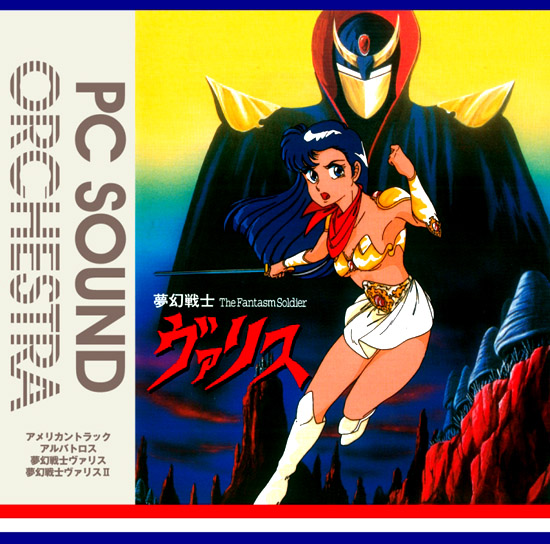Yuko Aso is a girl that just can’t catch a break. Since 1986, she has been the star of Fantasm Soldier Valis, an action game series from TELENET Japan that made a trickle in Japan, being one of the very first game to feature a prominent female protagonist during an era where muscle men ruled the arcades and home consoles, and also pushing forward the idea of cinematic storytelling in games by making use of animated story sections striving to be on par with TV animation. Over time, Valis was successful enough to be released across all home systems during the early 90s, and even have a few releases in the Western market. Sadly, it is today largely forgotten despite being a relatively quality franchise.
Valis still lives on in retro hearts, and its cult status still gives it opportunities in Japan to see a few releases in game and merchandise form. After a short stint as a hentai series officially sanctioned by TELENET Japan, the license is now in the hands of SUNSOFT, and with the acquisition came attempts to relaunch it’s name in more family friendly ways. One of these attempts is the recent Wave Master release, Valis: PC Sound Orchestra.
Read the review after the jump.
With SUNSOFT buying up all of TELENET Japan’s properties, this specific release actually features more than just Valis. Back in their heyday, TELENET was a well known and fairly well executed game developer on the scale of companies like Konami, producing a plethora of titles across all genres. A couple of these titles are featured on the first disc of this 3 disc compilation, namely American Truck and Albatros.
American Truck was TELENET’s very first game, an awkward high speed vertical racer with a large delivery truck. Its soundtrack isn’t particularly memorable or vast, featuring only 3 tracks total with pretty simplistic melodies, just serving as a catchy background sound rather than engaging song in itself. The leads are somewhat out of tune, due to the inexperience of TELENET at the time I would assume. The only song of note on this trio of tunes is the last one, “Sunny,” which is a soothing piano track reminiscent of “Last Wave” from OutRun. It’s a nice addition for historic value, but not so much for audible enjoyment.
Albatros is a golf game as the name would suggest for some sport fans, and fares much better. The leads are now much more focused and the overall compositions showing more strength. The general tone is more relaxed and a positive atmospheric one, backdropping the sunny golf plains, and cleverly using the cling of the club hitting the ball as a percussion element. The opening track “Rising Up” is also impressive in its length, clocking at over 7 minutes which is quite impressive for a game in 1986.
But onto the main entree of the collection, Fantasm Soldier Valis. Despite having more than 15 different releases total throughout the series, this set focuses solely on the PC-88 versions of Valis I and Valis II. Valis always presented itself very much like true animation property, and the soundtracks reflects this using a fusion of pop, jazz, classical and character centered motifs in its melodies. The first Valis game is perhaps best remembered for the first stage theme “Flash of Sword,” both due to its quality and the difficulty which resulted in few getting past the first stage. A strikingly dramatic stage theme with blindingly fast arpeggios, a trademark of the Valis series. Over 20 years, this song still stands as iconic. The bass driven boss theme is funky and catchy, if a not a tad bit too much on the happier side of things, contrasting the game’s visuals. The first half of the soundtrack comes off as passable apart from the great first theme, but it is the later half that truly represents the game. Similar to Castlevania, the game builds up towards the demon’s lair, and the closer you get, the more sinister these songs become, with riveting melodies packed with cinematic flair and orchestral hits. The “Visual act” tracks, used during the cutscenes, are especially strong, driving the intended emotions through musically, and being able to do so without the visual aid of the cutscene. The PC-88 version of this soundtrack does sound somewhat unevenly mixed at times, as some samples have clear moments of noise when they reach higher notes. Still it’s a great soundtrack ones it gets going, even if it takes a few tracks to truly get there.
Valis II came several years later, leading to a boost in the quality of the sound available for the game. This also led to it being presented in two different forms; The Yamaha YM2203 (OPN) and the Yamaha YM2608 (OPNA). Both these versions are available on this collection on separate discs. Compositional speaking, Valis II goes in much of the same direction as the first games, though with a darker sound overall, as the game’s story was noticeably more sinister than the first game. This soundtrack doesn’t take any time to warm up luckily, starting out fantastic with a dual opening theme across 2 tracks, “Virgin Crisis” (which is coincidentally the name of my autobiography) and “Sacred Sacrifice” (which is what we refer to when we are speaking of Jayson Napolitano’s vasectomy). Rather than focusing on faux orchestra elements, Valis II has more of a rock edge to it, no doubt due to the involvement of Tenpei Sato. That’s not to say it completely walks away from the first game’s sound, as there are plenty of classically charged melodies such as “Ever Green,” but overall, the melodies takes more to represent the hero’s bravery and progression than the looming danger of the environments. It’s quite a long soundtrack as well, standing at 1 hour and 15 minutes across 38 tracks, though a number of these are actually unused tracks exclusive to this release, as well as MUSIC Mode versions of certain tracks, that embellish ever so slightly on the tracks, but not to any extent where it matters much. At best, Valis II can be seen as an excellent mix of Mega Man and Castlevania, using the rock and action of the former mixed with the drama and grit of the latter.
The differences between the OPN tracks and the OPNA tracks also aren’t to that extent where it affects much of the overall output. The OPNA has some new effects and clearer samples, as well as more channels that allows for more balance, leading to a better stereo experience. The percussion sound weaker at times on the OPNA version, though with a general richer sound and better mix, it’s probably the way to go on a proper sound system.
For new fans, it might not be the best entry point to the history of Valis, as the MSX and X68000 both received their versions of Valis later on with much stronger sound, but this is more about showcasing the roots than to provide the best version of the many different ones out there. For old fans of Valis, it’s an awesome collectors item with some good TELENET goodies packed in and well worth tracking down. If you’re out to experience the very best versions of the soundtracks however, the older CD releases did a better job.
Tags: Fantasm Soldier Valis, PC-88, Reviews, Soundtracks, Sunsoft, TELENET Japan, Wave Master, Wavemaster









































Wow, insightful review on this release! I literally just saw this on Ebay today and went looking for more info online and here I come across your review that was posted today (now yesterday)? Damn, that’s good timing! I’m a Valis fan from way back so this compilation set is pretty cool sounding. Awesome, have a great day! 🙂
Glad you reviewed this instead of me. Yeah, great insight. I really don’t get why they had Valis II taking up two separate discs for what is essentially the same sound, though. Also, thought I told you never to mention my “Sacred Sacrifice?”